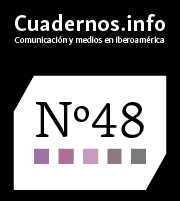Enseñanza del periodismo transmedia en Colombia, una experiencia pedagógica con estudiantes universitarios
DOI:
https://doi.org/10.7764/cdi.48.27827Palabras clave:
periodismo transmedia, periodismo convergente, periodismo digital, aprendizaje basado en proyectos, generación de contenidos, storytellingResumen
Este artículo socializa la sistematización de la experiencia pedagógica de la enseñanza del periodismo transmedia con base en el proceso de Aprendizaje Basado en Problemas (ABP), utilizado con estudiantes de periodismo de la Universidad de Bogotá Jorge Tadeo Lozano en los años 2016 y 2017. En su abordaje, los estudiantes trabajaron en la propuesta, investigación, producción y publicación de contenidos periodísticos, un ejercicio que tuvo como objetivo principal facilitar la comprensión teórica y práctica de los procesos convergentes, la producción de narrativas periodísticas y la interacción con las audiencias. La sistematización se sustenta en la observación de once proyectos en las etapas de conceptualización, producción de medios y contenidos a nivel narrativo y tecnológico, así como la gestión de redes sociales y la realización de actividades en escenarios no digitales. Asimismo, se basa en la valoración de la percepción de aprendizaje otorgada por los estudiantes de los grupos de proyecto. Estas observaciones permiten afirmar que el ABP resulta clave para lograr un aprendizaje significativo e integral; este método desarrolla habilidades en materia de estrategia, producción técnica y periodística para la multiplataforma, y otorga a los estudiantes competencias para relacionarse con sus audiencias. Del mismo modo, evidencia que el periodismo transmedia, desde la academia, necesita ser complementado y articulado sinérgicamente con otras propuestas y espacios mediáticos de formación, más allá del salón de clase. Este documento aporta elementos a considerar en la configuración de estrategias educativas en la enseñanza-aprendizaje del periodismo transmedia.
Descargas
Citas
Banco Mundial. (2017). Personas que usan Internet (% de la población) | Data [Subscriptions to cell phones are subscriptions to a public mobile pone | Data] Retrieved from https://datos.bancomundial.org/indicador/IT.NET.USER.ZS?contextual=default&end=2017&locations=CO&start=1990&view=chart
Bermúdez, C. (2018). Lógica práctica y lógica teórica en la sistematización de experiencias educativas [Practical logic and theoretical logic in the systematization of educational experiences]. Pedagogía y Saberes, 48, 141-151. Retrieved from http://www.scielo.org.co/pdf/pys/n48/0121-2494-pys-48-00141.pdf
Carranza, M. 01& Caldera, Juan (2018). Percepción de los Estudiantes sobre el Aprendizaje Significativo y Estrategias de Enseñanza en el Blended Learning [
Students' Perception of Significant Learning and Teaching Strategies in Blended Learning]. REICE. Revista Iberoamericana sobre Calidad, Eficacia y Cambio en Educación, 16(1), 73-88. https://doi.org/10.15366/reice2018.16.1.005
Costa, C., & Piñeiro, T. (2012). Narrativas audiovisuales: multiplataforma, crossmedia y transmedia [Audiovisual narratives: multi-platform, crossmedia and transmedia]. Icono 14, 10(2), 102-125.
DANE. (2017). Estimaciones 1985-2005 y Proyecciones 2005-2020 nacional y departamental desagregadas por sexo, área y grupos quinquenales de edad [Estimates 1985-2005 and projections 2005-2020 national and departmental disaggregated by sex, area and five-year age groups]. Retrieved from http://www.dane.gov.co/files/investigaciones/poblacion/seriesp85_20/EstimacionesProyecciones1985__020.xls
Garrett, J.J. (2011). The Elements of User Experience: User-Centered Design for the Web and Beyond (Second Edition ed.). New Riders.
Hernández-Sampieri, R. (2014). Metodología de la Investigación (Sexta Edición ed.) [Investigation methodology (Sixth Edition ed.)]. México D.F., México: McGraw Hill Education.
Jenkins, H. (2008). Convergence Culture: La cultura de la convergencia de los medios de comunicación [Convergence Culture: Where Old and New Media Collide]. (P. Hermida Lazcano, Trans.) Buenos Aires: Ediciones Paidós Ibérica, S.A.
Maldonado-Pérez, M. (Septiembre - Noviembre de 2008). Aprendizaje Basado en Proyectos Colaborativos. Una experiencia en educación superior [Learning based on collaborative projects. An experience in higher education]. Laurus. Revista de Educación, 14(28), 158-180. Retrieved from http://www.redalyc.org/pdf/761/76111716009.pdf
Mintic. (2017). Primera Gran Encuesta TIC / 2017. Estudio de acceso, uso y retos de las TIC en Colombia [First Great Survey TIC / 2017. Study of access, use and challenges of ICT in Colombia]. Retrieved from https://colombiatic.mintic.gov.co/679/articles-74002_cartilla_resumen.pdf
Moreno-Sánchez, I. (2012). Narrativa Hipermedia y Transmedia [Hypermedia and Transmedia Narrative] In V. P. (coord.), Creatividad y discursos hipermedia (págs. 21-40). Murcia, España: Universidad de Murcia, Edit.um Ediciones de la Universidad de Murcia. Retrieved from https://eprints.ucm.es/45471/1/NarrativaHyT-Isidro%20Moreno.pdf
Nieto, N. (2017). Transmediaciones en la producción de contenidos periodísticos especializados en economía [Transmediations in the journalistic content output in specialized economic media]. Cuadernos.Info, (40), 219-233. https://doi.org/10.7764/cdi.40.1037
Pellegrini, S., Puente, S., Porath, W., Mujica, C. & Grassau, D. (2011). Valor agregado periodístico: La apuesta por la calidad de las noticias [Journalistic Added Value: The bet for the quality of news]. Santiago de Chile: Ediciones Universidad Católica de Chile.
Porto, D. & Flores, J. (2012). Periodismo transmedia. Reflexiones y técnicas para el ciberperiodista desde los laboratorios de medios interactivos [Transmedia journalism. Reflections and techniques for the cyberjournalist from interactive media labs]. Madrid: Editorial Fragua.
Rost, A., & Liuzzi, Á. (2012). Reorganización de redacciones y nuevos perfiles profesionales [Reorganization of newsrooms and new professional profiles]. In A. Rost, & F. Bergero, Periodismo en contexto de convergencias (pág. 162). Rio Negro, Argentina: Publifadecs.
Sánchez Duarte, J., & Fernández Romero, D. (2015). Pensar con la acción. Aprendizaje por proyecto en la enseñanza del periodismo digital [Think with action. Learning by project in the teaching of digital journalism]. Opción, 31(5), 856-870. Retrieved from http://www.redalyc.org/pdf/310/31045570048.pdf
Sarsa, J. (2014). El perfil prosumidor de los estudiantes en la web 2.0 [The prosumer profile of students in web 2.0]. Journal for Educators, Teachers and Trainers, 5 (2), 74-87.
Scolari, C. (2013). Narrativas Transmedia: Cuando todos los medios cuentan [Transmedia Narratives: When all media counts]. Barcelona: Deusto - Centro Libros PAPF.
Scolari, C., Manuel, J., & Mar, G. (2012). Narrativas transmediáticas en España: cuatro ficciones en busca de un destino cross-media [Transmedia fiction in Spain: four fictions in search of a cross-media destination]. Comunicación y Sociedad, 137-163.
Villanueva-Mansilla, E. (2017). Convergencia mediática: lecciones y preguntas desde la experiencia peruana [Media convergence: lessons and questions from the Peruvian experience]. Revista de Comunicación, 16(1), 166-191. Retrieved from https://revistadecomunicacion.com/article/view/1013
Descargas
Publicado
Cómo citar
Número
Sección
Licencia
Derechos de autor 2021 Cuadernos.info

Esta obra está bajo una licencia internacional Creative Commons Atribución-CompartirIgual 4.0.















